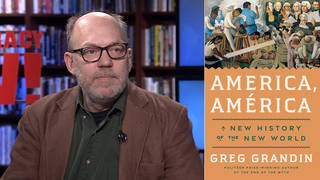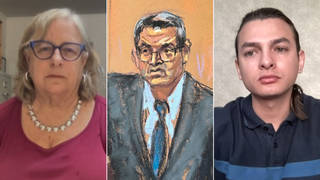
At least 15 lives have been saved so far, after the nation’s first supervised illegal drug injection sites opened in New York City about a week ago. The facilities provide clean needles and the opioid reversal medication naloxone, as well as medical care and drug dependency treatment options. This comes as U.S. overdose deaths topped 100,000 during the first year of the pandemic. While the New York facilities are the first to be government-approved, advocates have long fought for better and safer resources for people with addiction, and there are now over 120 drug injection sites operating worldwide. We speak with Kassandra Frederique, executive director of the Drug Policy Alliance, who says safe drug prevention sites are effective tools to keep people who use drugs alive, especially in Black and Latino communities that face the added threat of mass incarceration from decades of discriminatory policies.
Transcript
AMY GOODMAN: This is Democracy Now! I’m Amy Goodman, with Juan González. Officials in New York City say nine lives have been saved so far, after the opening of two new supervised illegal drug injection sites. The government-approved facilities are the first of their kind in the United States. They come as U.S. overdose deaths topped 100,000 during the first year of the pandemic. Locations offer clean needles and can administer the opioid reversal medication called naloxone, as well as provide medical care and drug dependency treatment options. Advocates have long fought for better and safer resources for people with addiction. There are now over 120 drug injection sites operating worldwide.
For more, we’re joined by Kassandra Frederique, the executive director of the Drug Policy Alliance, a national nonprofit fighting to end the so-called war on drugs and to build alternatives.
Kassandra, welcome to Democracy Now! So, explain what’s happening at these sites. These are illegal drug injection sites that are approved by New York City, the first in the country.
KASSANDRA FREDERIQUE: Thank you so much for having me.
So, yeah, these overdose prevention centers are places where people who are already publicly injecting, we are incentivizing them to come into these places so that they can sit down, learn strategies around injection that really reduce the harms that come with injection, that are able to have conversations about the substances that they’re using, and to use under the supervision of other people.
Part of the reason why this issue is so urgent is because our drug supply currently is being adulterated with a more fast-acting opioid called fentanyl. When this happens and the drug supply is contaminated, we are in a situation where people are using and overdosing faster, and then we’re getting more deaths. And so that’s part of the reason why we’re seeing such a surge.
And so, with these overdose prevention centers, people are being able to use under supervision. Therefore, if someone is overdosing, there is a greater chance — well, there’s people who will be able to revive them. And what I would offer is that the latest stats are that 15 people have been saved in the six days that these sites have been open, and we only see that number increasing.
JUAN GONZÁLEZ: And, Kassandra, I wanted to ask you about the overall implications of the epidemic of overdose deaths that the nation is undergoing now. Back in the 1970s, when I think Richard Nixon started, launched his “war on drugs” in 1971 — back then, during the heroin epidemic, I think the total number of overdose deaths in any one year, back in the '70s, was about 7,000. And then, in the ’80s, at the height of the crack cocaine epidemic, the largest number of overdose deaths was less than 9,000 in any one year. Now we're dealing with 100,000 in a 12-month period, according to the CDC, 10 times the number of people dying from drug overdose deaths now than back in the ’70s and the ’80s. The implications of that for public health and in terms of how government policy is shaped?
KASSANDRA FREDERIQUE: Yeah, this is an incredibly important point. And I think the thing that we point to is the role that criminalization plays in exacerbating a public health crisis. The explosion of mass incarceration, the consistent policies that focus on control as opposed to public health have only exacerbated the issues that we’re in right now. If we think about the heroin crisis in the ’70s and we think about the role of methadone, when we think about how restrictive it is, when we think about the lack of access to new medications like buprenorphine and the insidious racial disparities about who has access, we recognize that this moment is policy-created. Right? Our policies have put us in this situation, and that we are really in a moment where these prevention centers is about us creating more tools for us to deal with the problem that our decision-makers have created.
JUAN GONZÁLEZ: And in terms of the demographics of the drug overdose situation, because, obviously, back in the '70s and ’80s, it was largely within the inner cities among African Americans and Latinos. Now this epidemic started really in the rural areas and has moved into the cities, hasn't it? And it largely started first among working-class and poor whites and now is increasingly into the Black and Brown communities, as well?
KASSANDRA FREDERIQUE: I think it’s been more of a mix, right? So it has been rural white folks that have been suffering from overdoses, but I think part of the reason why you’ve seen a marshaling of resources is because this was also hitting middle-class, well-resourced white folks, right? That’s what gets the government and the status quo to respond, is because there’s also a class as well as race implication that’s happening, which has marshaled the kind of response that you’ve seen.
What we are seeing now is that there is a dramatic increase of the overdose crisis hitting Black and Latino communities in this country. In fact, in New York, where we have opened the overdose prevention center, the Black overdose — Black New Yorkers had the highest rate of overdose deaths and the largest absolute increase in rate between 2019 and 2020. And so we’re seeing such a dramatic increase. There have been studies that have shown that. There have been four states in the United States, at a study that was run out of Columbia, where Ohio, Kentucky, New York, where they have the highest overdose rates, the increase is happening among Black communities. And, you know, there are multiple states — there was another study that showed that in states like West Virginia, Washington, D.C., Missouri, Illinois, Michigan, Wisconsin, Minnesota, these places, the Black opioid overdose death rate is higher than white folks.
And so it’s really important for us to recognize. And also, this is what history shows, right? Like, there’s no crisis that’s happening in the United States that’s solely going to impact white folks, right? Like, if white folks start to get impacted, we will see a dramatic increase in the devastation that will happen to communities of color. And the thing that we, as advocates, are pushing for is, usually when that happens, the pendulum swings really rapidly back to criminalization. We’re seeing that at the federal level with the Biden administration continuing to push criminalization of fentanyl. And we, as advocates, know that when that happens, the public health push will recede, and the criminalization will take its place. And so it’s really important for us to have a conversation about how we need to keep public health at the center and at the forefront of our strategy in order to make sure that we do not continue the policies that have put us in this situation in the first place.
AMY GOODMAN: So, can you talk about where we stand in the world? Safer consumption spaces have been in operation in Europe, what, since the 1980s; in Canada, since 2003. Around 120 sites are operating around the world. Here in New York, we now have these first legal injection sites, now Boston, San Francisco, Washington state all considering this, these safe spaces away from police and incarceration. Talk about how this contributes to ending the “war on drugs,” Kassandra.
KASSANDRA FREDERIQUE: We want to keep people alive, and the “war on drugs” is a war on people, as many people have said before. And in order for us to actually win, we need our loved ones to be here with us. And that includes people who use drugs.
And I want to be really clear: These are the first sanctioned overdose prevention centers. People who use drugs have been finding strategies to keep themselves alive and well for a very long time. This comes out of a deep history and strategy of harm reduction. People who use drugs were the first people that were pushing for giving people who use drugs clean equipment like sterile syringes. And they have been operating these kinds of places for a long time to help save each other. This is us moving to help them to bring this out from the underground, to make sure that we can create an infusion of resources, and for us to actually have conversations about what it is that we need to keep our loved ones safe.
Oftentimes when we have these conversations, people are focusing on: “We want to get people to stop using drugs. We want people to return back to our lives.” What we have consistently heard from people who use drugs is that they need things to slow down around them. Overdose prevention centers give us the opportunity to give people who use drugs the resources and the time and the consultation to look at the choices that they’ve made, create the connections that they want, and also slow down the chaos that comes with criminalization. When people are using —
AMY GOODMAN: Kassandra?
KASSANDRA FREDERIQUE: Yes.
AMY GOODMAN: We have five seconds.
KASSANDRA FREDERIQUE: Yes.
AMY GOODMAN: I want to thank you so —
KASSANDRA FREDERIQUE: So, what I would offer —
AMY GOODMAN: Go ahead.
KASSANDRA FREDERIQUE: Thank you so much. What I would offer is that this is an opportunity for us to look at how do we center the needs of people who use drugs, how do we listen to them and create resources that are anchored in that.
AMY GOODMAN: Kassandra Frederique, executive director of Drug Policy Alliance, thank you so much.
And Juan and I hope you’ll join us tonight for the virtual celebration marking Democracy Now!'s 25th anniversary at 8 p.m. Eastern Time at democracynow.org. We'll be speaking with Noam Chomsky, Angela Davis, Martín Espada, Winona LaDuke, Arundhati Roy, Danny Glover, Danny DeVito and more. I’m Amy Goodman, with Juan González.













Media Options